AYR MASTERPLAN
FEBRUARY 2017

In collaboration with acclaimed international land artist Charles Jencks the masterplan for Ayr has been given planning consent. The project has been conceived as an urban square next to the River Ayr that will be used for festivals and events.
The scheme, focuses around a new glazed structure, that will open up a number of views blocked by post-war development and includes commercial, cultural, leisure, community, hotel and residential buildings. South Ayrshire Council has already committed to building a new council office for 350 of its staff as part of the scheme.
Ayr Renaissance began purchasing the mainly 20th century buildings on the site almost four years ago with funding from the council and the Scottish Government’s Regeneration Capital Grant Fund.
Demolition will begin immediately on the buildings within the plot, which falls inside the Ayr Central Conservation, following the approval for the masterplan by South Ayrshire Council last week.
Archaeologists will work alongside the demolition contractors in preparation for a six-month dig.
James Knox, chairman of Ayr Renaissance, said: ‘This decision marks a turning point in the fortunes of Ayr. Decades of blight will be swept away, opening up the river to the town’s people for the first time in generations. ‘Our masterplan offers a humane and beautiful solution to the transformation of this key site, which will act as a magnet for visitors, office workers and inhabitants alike. It marks a sea change in the economy of the town.’
FRAMELESS ARCHITECTURE
AUGUST 2015

Our classification of the world is the result of a desire to impose order on the chaos we are born into. In nature we classify the species, in society we classify our relationships, and in architecture we classify the spaces we design and inhabit. In many cases, classification is a useful tool that allows us to root ourselves in time and space.
Classification can also be the enemy of imagination, suffocating our desire to wonder and discover new associations. It can limit the understanding of what surrounds us and disjoint elements that should not be separated. Framing perception can become a reductive force.
In his book Atlas: How to Carry the World on One’s Back, Didi Huberman uses ‘atlas’ in its broadest sense to mean a ‘collection of images’. Huberman explores two different ‘uses of reading’: a denotative sense in search of messages, and a connotative sense in search of montages. The dictionary is a predictable tool for the former, and the atlas is the ‘unexpected apparatus’ for the latter[1].
The atlas is frameless and endless. It surpasses boundaries and restrictions and is in a state of constant renewal. The atlas enables our imagination to trigger new associations, new relations. Although we may start with a search for the specific, we may then wander endlessly, unlimited by a defining frame.
Architectural education, architectural research and architectural practice have suffered for too long from being limited by a defining frame that has placed them in different dictionary entries. It is now time to rethink this model, which shapes our lives, our careers, and ultimately our contribution to society. If we are to replace the dictionary with the atlas, if we are to substitute the definitive meaning with the endless search for new relations, we will have a new model of architecture where education, research and practice are interwoven and intrinsic to one another.
For this new model to succeed, we must completely awaken our imagination. Education, research and practice will be symbiotic and won’t be understood without each other. As a result, transverse readings and meanings will develop within our work. These will be found not only in the individual but also in the collective. In our office, inspired by Aby Warburg’s Mnemosyne Atlas, we will develop our own Atlas where images of our endlessly evolving inspirations and aspirations will be captured. Our Atlas will be a new ground from which meaning, space and relationships will grow. Our Atlas will enable us to read what has never been written[2].
[1] Georges Didi-Huberman (2010). Atlas. ¿Cómo llevar el mundo a cuestas?. Madrid: TF Editores/Museo Reina Sofía . 16-17.
[2] Georges Didi-Huberman (2010). Atlas. ¿Cómo llevar el mundo a cuestas?. Madrid: TF Editores/Museo Reina Sofía . 14.

